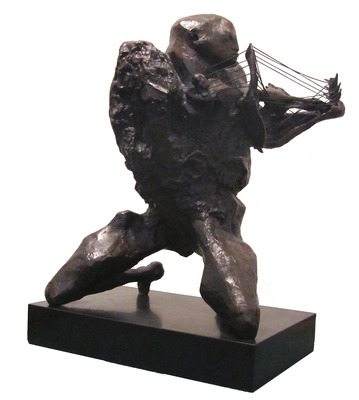Michael Ayrton (1921-1975)
Maze Music
An artist, writer, printmaker, sculptor, critic, broadcaster and novelist, Michael Ayrton was born in London in 1921 to the writer Gerald Gould and the Labour politician Barbara Ayrton (he adopted his mother's name professionally). He studied art at Heatherley's, St John's Wood School, and in Paris where he shared a studio with John Minton.
During the Second World War, Ayrton worked with Minton to design the sets and costumes for John Gielgud's production of Macbeth (1940-42). The designs were shown at the Leicester Galleries in 1942. He continued to develop as a stage designer throughout the 1940's and as well as turning his talents to book design and illustration. In 1944 he began to write, succeeding John Piper as art critic on the Spectator.
In 1946 Ayrton visited Italy for the first time leading to a series of paintings influenced by his studies of the early Renaissance painters. Through his studies he also discovered sculpture, although it was some 7 years before he came to make sculptures himself.
Throughout the late 1940's Ayrton travelled extensively, mainly in France and Italy, to paint, write and above all to draw. As his draughtsmanship matured it became clear to him that he needed to make sculptures to release his drawings. In 1951 he moved to Essex and began to work as a sculptor. He received no formal training in the technique except for some valuable technical advice from Henry Moore and from studying the work of masters including Donatello, Degas and Rodin. His greatest stimulus for his sculptural work was a visit to Greece in 1958 which inspired a passionate interest in the related myths of Icarus, Daedalus and the Minotaur.
Ayrton's work is held in several important London collections including the Tate Gallery and National Portrait Gallery as well as in the Museum of Modern Art, New York.
Bronze
Signed and numbered 'Michael Ayrton 12/12' on the side of the leg
Conceived in 1972 and cast in an edition of 12
18 x 13 x 8 1/2 ins
Provenance
Acquired from the artist's estate by private collector, UK
Exhibited
'Michael Ayrton: Maze and Minotaur - An exhibition of work on the theme', Bruton Gallery, Somerset, 1972 (another cast exhibited)
'Michael Ayron Recurring Themes and Images', Bruton Gallery, Somerset, 1981 (another cast exhibited)
'Michael Ayrton Sculpture, Paintings, Drawings and Prints', Beaux Arts, London 1995 (another cast exhibited)
Literature
'Michael Ayrton - Maze and Minotaur', Bruton Gallery, Somerset, 1972, p.30, no.36 (b&w illustrated)
'Michael Ayrton: An Illustrated Commentary', Peter Cannon-Brookes, City Museums and Art Gallery, Birmingham, 1978, p.127, pl.231 (b&w illustrated)
The concept of the Maze, its maker and its occupants, were to preoccupy Michael Ayrton for over ten years. Daedalus was the starting point for the series called Maze Makers and Maze Figures.
Maze Music evolved from an earlier sculpture, Maze Player, executed in 1965, in which the maze is transformed into a musical instrument.
